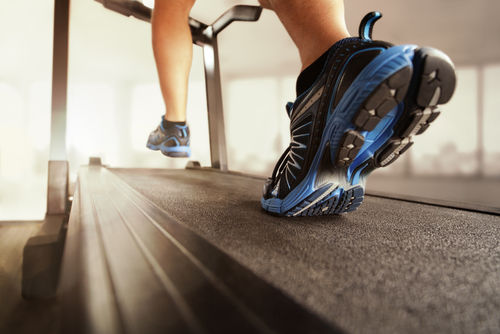Treadmill Training Plus Virtual Reality Reduces Falls in Older Adults, Study Shows

A new study showed that treadmill training with a virtual reality component reduced fall rates compared to treadmill training alone in a group of older adults with Parkinson’s disease, dementia, or mild cognitive impairment.
The research paper, “Addition of a non-immersive virtual reality component to treadmill training to reduce fall risk in older adults (V-TIME): a randomized controlled trial,” was published in The Lancet.
Researchers at the Tel Aviv University-Tel Aviv Sourasky Medical Center for the Study of Movement, Cognition and Mobility (TASMC) and TAU’s Sackler School of Medicine conducted the six-week interventional study that combined treadmill training with virtual reality (VR). Targeting cognitive aspects of safe ambulation and mobility, they tested to see if the combined intervention could lead to fewer falls.
It has been long-established that patients with Parkinson’s disease, dementia, or mild cognitive impairment are at high risk for falling and seriously hurting themselves.
“Falls often start a vicious cycle with many negative health consequences,” Anat Mirelman, PhD, the study’s co-lead author, said in a news release. “The ability of older people to negotiate obstacles can be impaired because of age-related decline in cognitive abilities like motor planning, divided attention, executive control and judgement. But current interventions typically focus almost exclusively on improving muscle strength, balance, and gait.”
Mirelman said the study approach helped improve physical mobility and cognitive aspects that are important for safe walking.
“We found that virtual reality plus treadmill training helped to reduce fall frequency and fall risk for at least six months after training — significantly more than treadmill training alone. This suggests that our use of virtual reality successfully targeted the cognitive aspects of safe ambulation to reduce the risk of falls,” Mirelman said.
The team of researchers gathered data from 282 people (ages 60 to 90) with motor and cognitive deficits, and who had fallen two or more times within six months before the study. Among the participants, 130 had Parkinson’s disease and 43 had mild cognitive impairment.
Participants were randomized into two groups: one group received six weeks of treadmill training plus VR (146 participants), and the other group received six weeks of treadmill training alone (136 participants).
The VR system included a camera and screen that allowed participants to watch their feet waking in real-time. The computer-generated simulation presented real-life challenges such as multiple pathways, obstacles, and distractions that required the participants to constantly adjust their steps.
Prior to the intervention, the fall rate was similar between the two groups.
Six months after the intervention, the rate of falls was nearly 50 percent lower in the group that performed treadmill training plus VR. The fall rates of participants who only did treadmill training did not significantly decrease.
Prof. Jeff Hausdorff, the study’s other co-leader, said that project satisfaction questionnaires completed by participants provided surprising results. The virtual reality group was very satisfied with the project and expressed a greater desire to continue using what they called “the game” for more exercise.
“This suggests that the virtual reality not only led to fewer falls, it was also more likely to be used in the long-term. Exercise needs to be fun and effective if it is going to be used continually,” Hausdorff said.
The largest improvement overall was seen in Parkinson’s patients.
“It was very exciting to see such improvement in the presence of a neurodegenerative disease. Still, we need to conduct further research to verify the results and better understand why the fall rates were so responsive in the people with Parkinson’s disease,” Hausdorff said.
Mirelman believes that the approach could work in various settings because treadmills are widely available and adding the virtually reality component costs only about $4,500. But she agreed that more studies are needed.
“Future studies need to examine whether treadmill training plus virtual reality could be used as part of a prevention package to treat fall risk before falls become common and before injuries occur,” Mirelman said.






